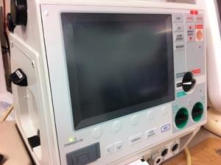

© All rights reserved galwayclinic.com 2013

Galway Clinic Facebook page
Tel: +353 (0) 91720170 brendan.ocochlain@galwayclinic.com
Cardioversion
What is cardioversion?
Cardioversion is a procedure in which an electrical shock is delivered to the heart to convert an irregular or fast heart rhythm (called an arrhythmia) to a normal heart rhythm. During cardioversion, your doctor uses a cardioverter machine or external defibrillator to send electrical energy (or a “shock”) to the heart muscle to restore the normal heart rhythm.
Defibrillator used to deliver energy to the heart during cardioversion
Cardioversion can be used to treat many types of fast or irregular heart rhythms. The most common
irregular heart rhythms that require cardioversion include atrial fibrillation and atrial flutter. Life-saving
cardioversion may be used to treat ventricular tachycardia or ventricular fibrillation (a rapid, life-
threatening rhythm originating from the lower chambers of the heart).
Why is the cardioversion procedure needed?
Your doctor may recommended that you have a cardioversion procedure to restore your heart rate and rhythm to normal, so you heart can pump as it should. Sometimes, irregular heart rhythms can cause symptoms including: • A pounding or fluttering in your chest • Shortness of breath • Chest discomfort • Dizziness or extreme fatigue These symptoms are signs that your heart is not pumping enough blood to your body. Even if you barely notice your symptoms, irregular heart rhythms that are left untreated can lead to more serious problems, such as a heart attack or stroke.



Galway Clinic Facebook page
Cardioversion
What is cardioversion?
Cardioversion is a procedure in which an electrical shock is delivered to the heart to convert an irregular or fast heart rhythm (called an arrhythmia) to a normal heart rhythm. During cardioversion, your doctor uses a cardioverter machine or external defibrillator to send electrical energy (or a “shock”) to the heart muscle to restore the normal heart rhythm.
Defibrillator used to deliver energy to the heart during cardioversion
Cardioversion can be used to treat many types of fast or irregular
heart rhythms. The most common irregular heart rhythms that
require cardioversion include atrial fibrillation and atrial flutter.
Life-saving cardioversion may be used to treat ventricular
tachycardia or ventricular fibrillation (a rapid, life-threatening
rhythm originating from the lower chambers of the heart).
Why is the cardioversion procedure needed?
Your doctor may recommended that you have a cardioversion procedure to restore your heart rate and rhythm to normal, so you heart can pump as it should. Sometimes, irregular heart rhythms can cause symptoms including: • A pounding or fluttering in your chest • Shortness of breath • Chest discomfort • Dizziness or extreme fatigue These symptoms are signs that your heart is not pumping enough blood to your body. Even if you barely notice your symptoms, irregular heart rhythms that are left untreated can lead to more serious problems, such as a heart attack or stroke.

Galway Site Design






























